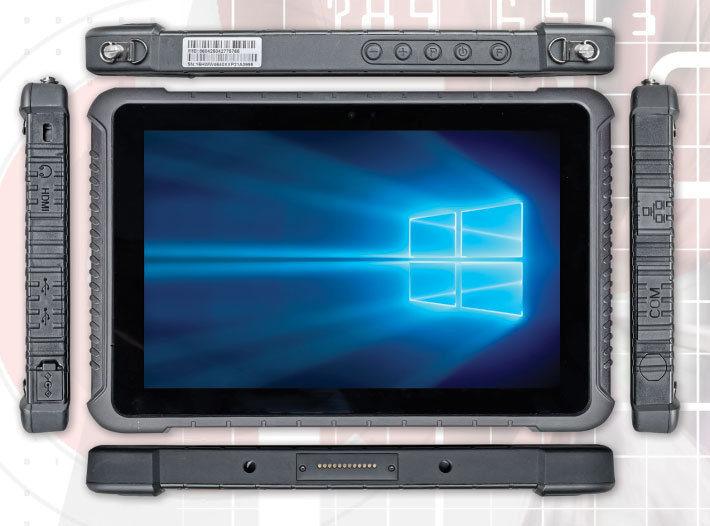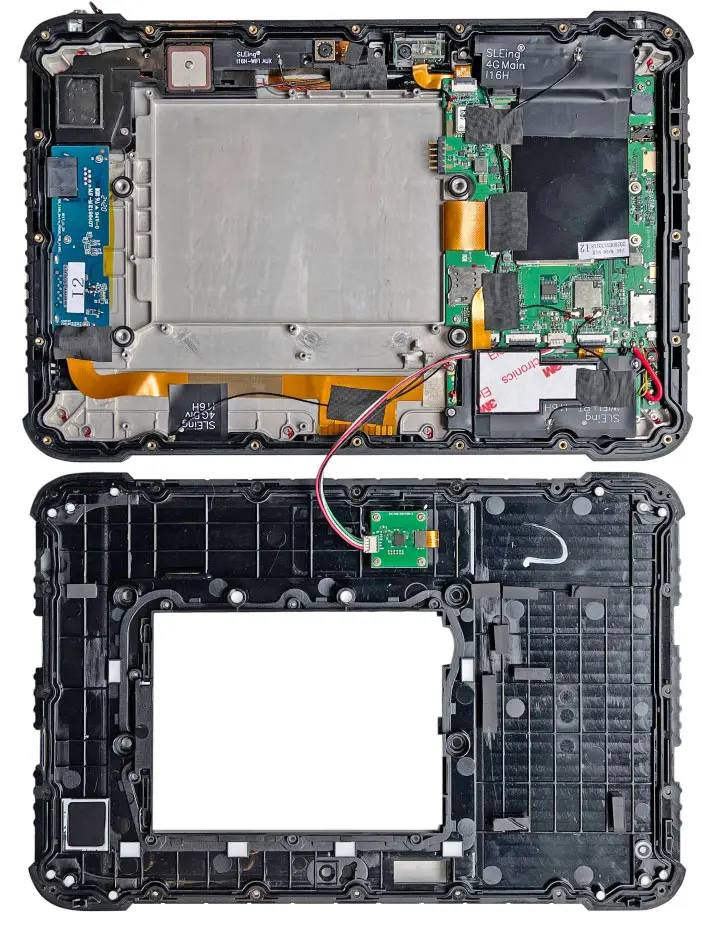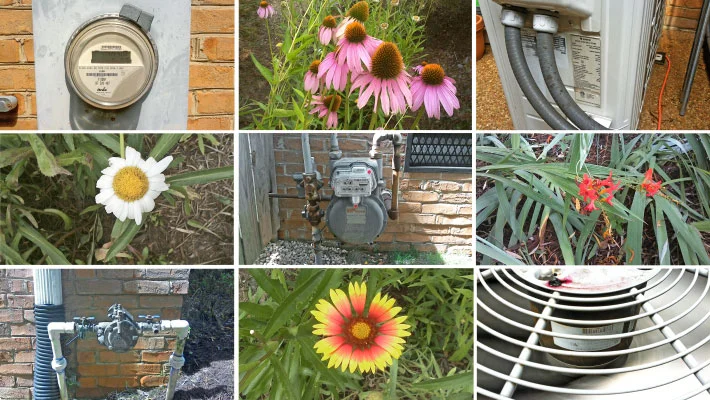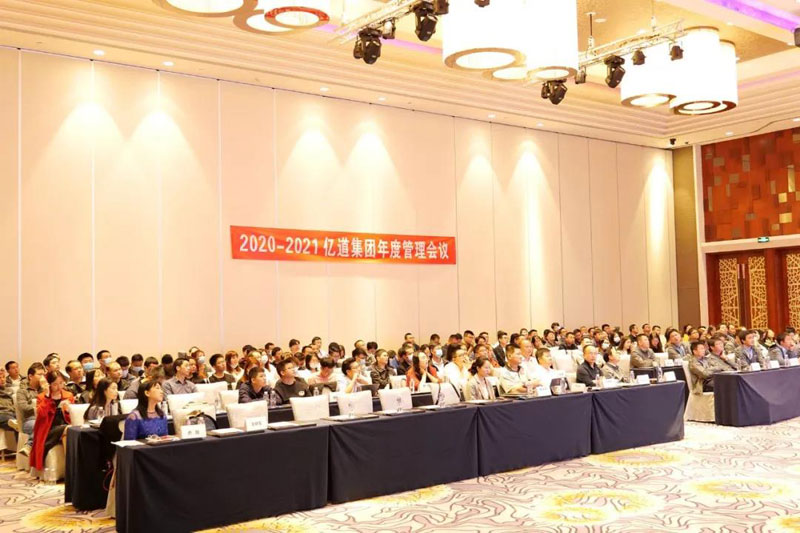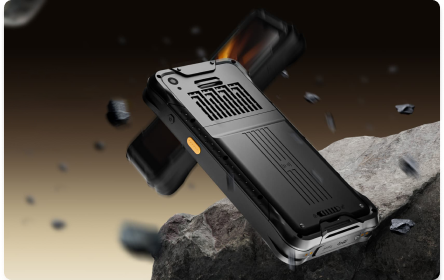
Par Conrad H. Blickenstorfer; photographie par Carol Cotton
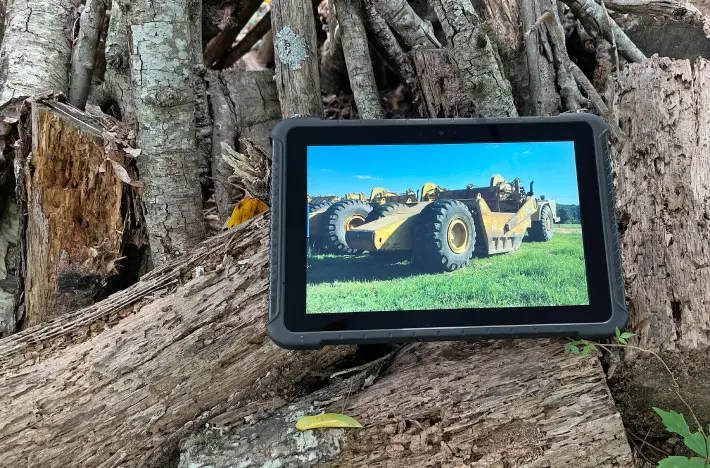
Emdoor a été fondée en 2002 en tant que concepteur et fabricant d'ordinateurs de poche robustes, de tablettes, d'ordinateurs portables, de PC et d'ordinateurs montés sur véhicule, ainsi que fournisseur de solutions matérielles et logicielles personnalisées. À ce stade, Emdoor ne vend pas de produits sous sa propre marque. Cela peut arriver à un moment donné, mais pour l'instant, ils sont l'un des fournisseurs chinois les plus importants et les plus expérimentés de systèmes informatiques robustes et servent de partenaire ODM ou OEM à de nombreuses entreprises de premier rang.
Infos Emdoor a une usine à Shenzhen et une équipe de R & D de plus de 300 personnes. Ils peuvent produire 15 000 à 30 000 appareils robustes par mois, ont une liste d'environ 50 produits mobiles robustes, et leur objectif est de fournir du matériel industriel rentable et parfois aussi des solutions logicielles pour une utilisation dans la logistique d'entrepôt, l'automatisation industrielle, les soins de santé, l'exploration pétrolière, la cartographie extérieure, l'inspection automobile, application de la route, Éducation, patrouille de frontière, services au détail, terminaux de libre service, vision par ordinateur, maison futée, transport intelligent, et semblable.
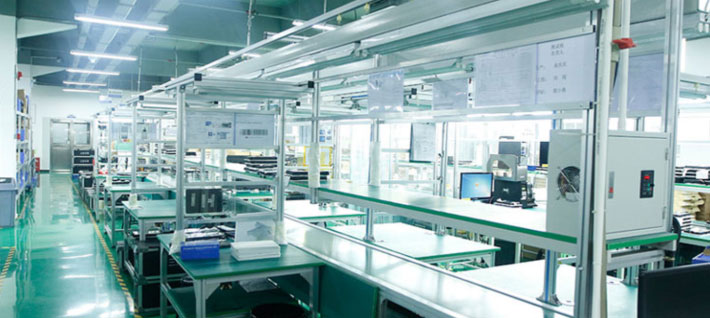
Alors que dans cet article, nous couvrons la tablette Windows IN-I16H de la société en particulier, une grande partie des centres de discussion non seulement sur ce produit tablette particulier, mais sur les produits du marché OEM en général.
Le rôle des OEM/ODM
Dans le passé, la plupart des appareils électroniques fabriquaient leurs propres produits directement dans le pays où ils se trouvaient. Certaines pièces peuvent avoir été externalisées ou produites ailleurs, mais pour la plupart, tout a été conçu, fabriqué et assemblé en un seul endroit. Un excellent exemple de cette approche était l'usine rouge géante de Henry Ford à Detroit. Le minerai de fer et d'autres matières premières sont entrés dans l'immense complexe d'un côté, et des voitures entièrement assemblées sont sorties de l'autre.Le marché actuel est mondial et il n'est généralement plus possible de tout produire en un seul endroit. Il y a, bien sûr, des exceptions, mais pour la plupart, les composants sont achetés à partir de toutes sortes d'endroits et assemblés dans divers endroits, tous en fonction du coût, de la logistique et de la rentabilité. Cette dynamique a donné naissance à la formation des OEM-Original Equipment Manufacturers-et des ODM-Original Design Manufactures. Les OEM fabriquent un produit selon la conception et les spécifications exactes de la société qui vend finalement le produit avec son nom. Les ODM conçoivent et fabriquent un produit entièrement par eux-mêmes. Et ensuite vendre le produit à des entreprises qui y mettent leur nom et leur marque.
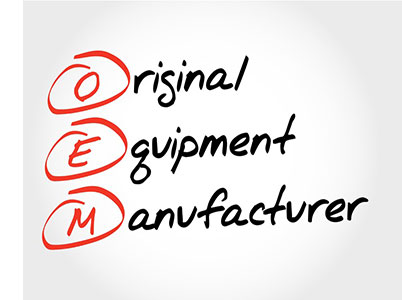 Quels rôles jouent les OEM et les ODM aujourd'hui? Très importantes. Presque tous les produits électroniques grand public aujourd'hui ne sont plus fabriqués par les entreprises que la plupart des gens pensent les fabriquer. Peu de ceux qui ne sont pas initiés de l'industrie, par exemple, ont entendu parler de Hon Hai Precision Industry. Mieux connu sous le nom de Foxconn, Hoi Han avait des revenus de 172 milliards de dollars en 2019. C'est plus que les revenus annuels de Microsoft, HP, IBM ou Dell.
Quels rôles jouent les OEM et les ODM aujourd'hui? Très importantes. Presque tous les produits électroniques grand public aujourd'hui ne sont plus fabriqués par les entreprises que la plupart des gens pensent les fabriquer. Peu de ceux qui ne sont pas initiés de l'industrie, par exemple, ont entendu parler de Hon Hai Precision Industry. Mieux connu sous le nom de Foxconn, Hoi Han avait des revenus de 172 milliards de dollars en 2019. C'est plus que les revenus annuels de Microsoft, HP, IBM ou Dell.
Quel est l'impact de cela sur le marché de l'informatique mobile robuste? À ce stade, une grande variété d'ordinateurs de poche, de tablettes, d'ordinateurs portables et de panneaux PC robustes sont fabriqués par des OEM et des ODM, puis vendus sous des noms familiers aux utilisateurs finaux et locaux peuvent être structurés sous de nombreuses formes différentes. Un OEM peut fabriquer une ligne de produits selon des spécifications très précises pour un seul client, et ce client peut avoir une exclusivité à la ligne. Ces produits ne sont alors disponibles que auprès d'une seule entreprise, ce qui en fait essentiellement un «fabricant virtuel». Cependant, il est également courant qu'un ODM crée un produit et vende ensuite ce produit exact à plusieurs clients. Ces clients peuvent alors y apposer leur étiquette et rien de plus. Entre ces deux extrêmes, il y a beaucoup de nuances de gris.
Hoes tout cela s'applique-t-il à Infos Emdoor et à la tablette IN-I16H? Emdoor est à la fois un ODM et un OEM, et celui qui se spécialise dans la fabrication de produits informatiques robustes. Les clients d'Emdoor sont des entreprises qui fournissent une technologie robuste à leurs propres clients utilisateurs finaux. Le marché de l'informatique robuste est, bien sûr, beaucoup plus petit que le marché de la technologie grand public, et Emdoor est beaucoup plus petit que Foxconn (qui tire environ la moitié de ses revenus d'Apple). Mais c'est bascialement la même chose.
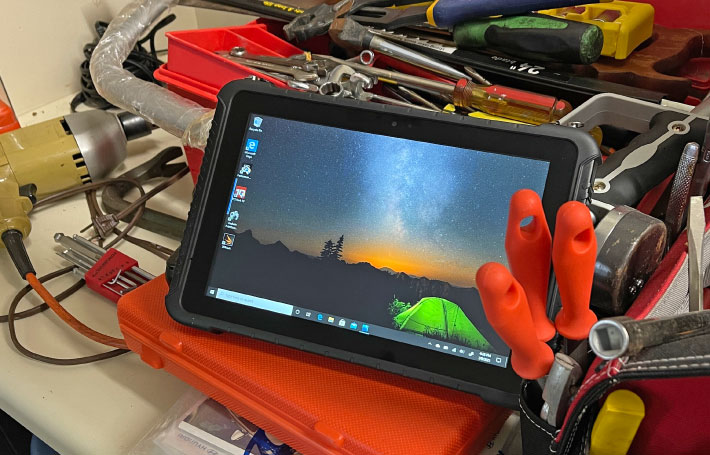
Qui sont les clients d'Emdoor? Ce sont principalement des entreprises qui s'adressaient à leurs propres marchés et souvent spécialisés. Les clients d'Emdoor vendent des équipements informatiques robustes à des entreprises qui combinent le matériel avec leur nom, leur histoire, leur expertise, leurs logiciels, leurs solutions clés en mains, leurs services et leurs accords de conseil. Les clients d'Emdoor peuvent être de grands noms bien établis dans leurs domaines. Ces clients peuvent avoir des exigences précises de personnalisation, leurs propres couleurs et leurs propres marques. Mais les clients d'Emdoor peuvent également être des revendeurs, de grands utilisateurs finaux, des intégrateurs de systèmes, et plus encore.
Plate-forme de tablette robuste de 10 pouces OEM IN-I16H d'Emdoor
Alors que de nombreux clients aiment faire affaire avec l'une des principales marques de matériel et de services robustes, pour d'autres, travailler avec un OEM/ODM comme Emdoor est plus logique. En tant qu'OEM/ODM, des entreprises comme Emdoor peuvent offrir des avantages en termes de coûts. Les conceptions OEM/ODM sont plus facilement personnalisables pour répondre aux besoins de différents clients, y compris des produits personnalisés avec des étiquettes, des couleurs et des matériaux établis. Les OEM/ODM sont également plus susceptibles d'offrir une grande variété d'E/S et ils peuvent prendre en charge différentes technologies, normes et niveaux de performance.
Alors regardons la tablette Emdoor IN-I16H Windows et voyons comment la société est allée créer une implémentation du facteur de forme générique de la tablette de 10 pouces, un avec l'attrait inhérent, mais aussi un pas si unique que de donner immédiatement son origine. Ci-dessous, vous pouvez voir la IN-I16H de l'avant et des quatre côtés.
À son crédit, Emdoor a proposé un design épuré qui prend le facteur de forme de base d'une tablette tactile capacitive robuste et ajoute subtilement une personnalité unique ainsi qu'une connectivité et des fonctionnalités plus câblées que celles couramment disponibles.
Le paquet de 11,0x7,4 pouces donne au IN-I16H robuste une empreinte pas beaucoup plus grande que votre tablette grand public typique de 10 pouces. C'est un design élégant et utile qui ressemble clairement plus à un outil sérieux pour le travail qu'à une déclaration de mode. Pourtant, malgré sa construction robuste et sa fonctionnalité et une épaisseur de 0,87 pouces, notre IN-I16H d'examen ne pesait que 2,2 livres.
Ci-dessous, vous pouvez voir le côté droit (en haut) et gauche (en bas) de la IN-I16H, avec les couvercles de port de protection ouverts pour une meilleure visualisation des ports. Sur le côté droit, vous trouverez un port série DB9 standard et une prise LAN RJ45.
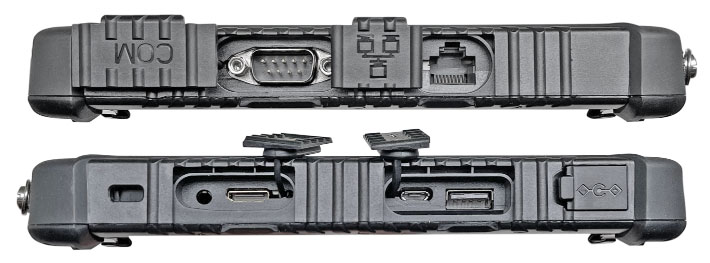
Sur le côté gauche, il y a la prise d'alimentation, un port USB Type-A, un port micro-USB, un port HDMI 1.4a Type C, une prise audio standard de 3,5mm et une fente de verrouillage Kensington.
Performance ciblée
Les entreprises OEM comme Emdoor doivent planifier soigneusement les niveaux de performance globaux de leurs offres de produits informatiques mobiles. En plus des compromis habituels de taille/poids/coût et de l'équilibrage inhérents à toute conception mobile, les clients OEM peuvent avoir des priorités très différentes, allant du coût le plus bas possible à la performance la plus élevée possible. Pour y remédier, Emdoor propose des tablettes de classe 10 pouces basées sur une grande variété de processeurs à la fois sur Windows et sur Android. Pour Windows, Emdoor dispose de tablettes hautes performances basées sur des processeurs Intel Core, mais propose également des modèles à faible coût comme les IN-I16H.
| Performance | Infos Emdoor | |
| Modèle (version testée) | IN-I16H | |
| Année testée | 2021 | |
| Processeur | Atome d'Intel | |
| Modèle de processeur | X5-Z8350 | |
| Vitesse CPU | 1,44 GHz | |
| Max. CPU Turbo | 1,92 GHz | |
| Noyaux/fils | 4/4 | |
| PassMark 6.1 dans l'ensemble | 587.8 | |
| PassMark 9 dans l'ensemble | 652.8 | |
| CrystalMark dans l'ensemble | 88,847 | |
| PC Mark 10 dans l'ensemble | 850.0 | |
| GeekBench 5 noyau unique | 183 | |
| GeekBench 5 Multi Noyau | 572 | |
| GeekBench 5 Ouvert CL | 1,112 |
En effet, bien que tout le monde aime les hautes performances, cela a un coût-les puces mobiles Intel haut de gamme peuvent facilement coûter plusieurs fois plus cher qu'une puce bas de gamme. Il est donc plus logique d'optimiser le produit pour des marchés cibles particuliers. Si un marché ou une application a besoin d'une tablette robuste à faible coût pour des charges de traitement connues, cela n'a aucun sens de la rendre évolutive pour des performances beaucoup plus élevées.
C'est le cas du IN-I16H. L'objectif ici était d'offrir une plate-forme de tablette robuste et robuste et adaptée à un grand nombre d'applications sur le terrain, mais elle devait également être économique et utiliser une puce qu'Intel s'était engagé à garder disponible pendant une période prolongée.
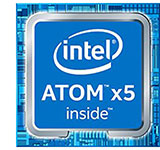 Le X5-Z8350 de quadruple-noyau de 1.44 gigahertz fait partie de la plate-forme 64-bit du système-sur-puce de «Cherry Trail» d'Intel d'Intel qui est basé sur la technologie de processus 14nm et vient avec des graphiques d'Intel HD de Broadwell-architecture.
Le X5-Z8350 de quadruple-noyau de 1.44 gigahertz fait partie de la plate-forme 64-bit du système-sur-puce de «Cherry Trail» d'Intel d'Intel qui est basé sur la technologie de processus 14nm et vient avec des graphiques d'Intel HD de Broadwell-architecture.
Le X5-Z8350 a une puissance thermique très basse de conception de juste 2 watts et peut atteindre des fréquences de rafale de jusqu'à 1.92 gigahertz. Comparé à la plate-forme de prédécesseur bien considéré "Bay Trail" qui a trouvé une utilisation dans de nombreux appareils robustes bas de gamme, les puces "Cherry Trail" comparables ne sont pas nécessairement plus rapides, mais leurs sous-systèmes graphiques sont plus rapides.
La tablette ci-dessus montre les performances de la tablette robuste Emdoor IN-I16H dans diverses suites de référence populaires.
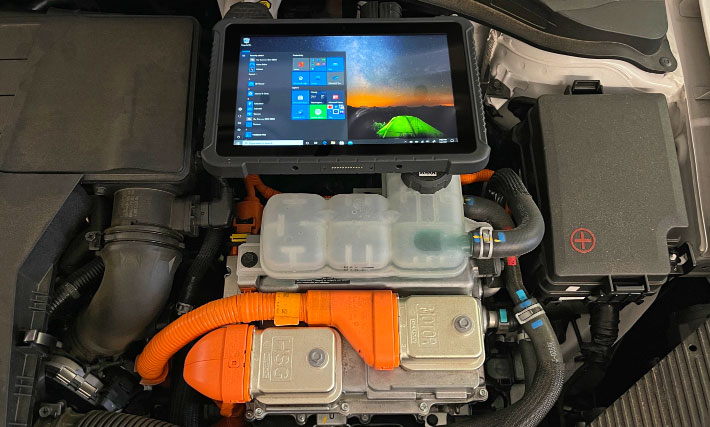
Quelle durée de vie de la batterie peut-on attendre de la tablette IN-I16H Emdoor? Compte tenu de son processeur Atom frugal, le tirage d'énergie devrait être faible. D'autre part, il a un affichage assez grand et lumineux. La fiche technique officielle revendique jusqu'à huit heures de vie de la batterie.
| Emdoor IN-I16H BatteryMon Puissance Draws (au ralenti) | |||
|---|---|---|---|
| Niveau de rétroéclairage | Le plus sombre | 50% | Les plus brillants |
| Max Batterie | 3,5 watts (10,6 heures.) | 4,3 watts (8,6 heures) | 5,4 watts (6,9 heures) |
| Max Performance | 4,0 watts (9,3 heures) | 4,8 watts (7,7 heures) | 6,2 watts (6,0 heures) |
Ces chiffres-qui, bien sûr, peuvent varier considérablement en fonction de l'utilisation-sont parmi les plus bas que nous ayons jamais enregistrés. Compte tenu de la capacité de 37 watts-heure de la batterie, 3,5 watts se traduirait par 10,6 heures, et le tirage le plus élevé que nous avons observé, 6,2 watts, signifierait près de six heures.
L'approche de la conception et de la fabrication des tablettes d'Emdoor
En ce qui concerne la conception de matériel informatique mobile robuste, l'apparence des choses à l'intérieur compte autant ou plus que ce qui est à l'extérieur. Le style extérieur et les bons regards attirent les yeux, et la conception ergonomique rend un produit facile à tenir et à utiliser. Mais c'est ce qui est à l'intérieur qui détermine la durabilité et la fiabilité d'un appareil et comment il sera capable de résister à une utilisation quotidienne difficile et aux éléments. C'est à RuggedPCReview que nous démantelons, examinons, puis remontons les unités d'examen. Cela fait partie du processus de test RuggedPCReview. Cela révèle la logique et la qualité de la conception interne, et nous pouvons voir si les ports scelleront et protégeront comme ils le devraient, s'il y a des composants et des connexions qui peuvent se desserrer, comment la batterie est intégrée dans la conception, si le service et la réparation sont faciles/possibles, si l'appareil est évolutif, Et à quel point la conception globale est bien exécutée.Passer cet examen visuel est important, compte tenu des exigences supplémentaires en matière de durabilité et de fiabilité des appareils robustes. Il est également important supplémentaire pour des produits d'OEM parce qu'ils doivent vivre jusqu'au rigoureux des clients de clients qui les ont alors rebranding pour la vente dans leurs marchés cibles, les adapter aux besoins de leur propre client dans des domaines particuliers, ou les empaqueter en tant qu'élément des solutions clés en main spécialisées de matériel/logiciel.
Cela oblige les produits OEM à être conçus à partir de zéro pour être aussi flexibles que possible, couvrir autant d'utilisations et d'applications potentielles que possible, et permettre autant de personnalisation que possible.
Comment fonctionne le IN-I16H Emdoor dans tous ces domaines? Démonter la tablette est facile. Tout ce qui est nécessaire est un tournevis Torx T6 pour défaire environ 20 petites vis, et un petit tournevis cruciforme pour les huit petites vis supplémentaires à l'intérieur du compartiment de la batterie. Pare-chocs d'angle de protection sont souvent des pièces séparées, ce qui permet au fabricant de différencier les niveaux de conception et de protection. Emdoor a choisi d'intégrer les pare-chocs surélevés dans le boîtier lui-même. Une fois toutes les vis retirées, les deux moitiés se séparent facilement. Emdoor offre la partie avant en noir ou noir et argent, et il serait facile pour eux d'offrir des couleurs supplémentaires. Les portes d'E/S de protection de la tablette sont sécurisées avec des longes en caoutchouc et sont probablement remplaçables.
Le logement du IN-I16H d'Emdoor se compose d'un avant comme une boîte en polyuréthane thermoplastique qui contient non seulement l'affichage mais également toute l'électronique à la seule exception du module facultatif de lecteur d'empreintes digitales qui est monté sur l'arrière. Contrairement aux conceptions de tablettes bas de gamme qui sont souvent toutes en plastique, la tablette Emdoor possède un châssis en magnésium solide et complexe qui offre non seulement un montage sécurisé pour tous les composants, mais ajoute également une résistance et une rigidité importantes.
Le dos de la tablette est fondamentalement juste une couverture pour la boîte frontale. Il y a un certain coffering pour la rigidité supplémentaire. L'étanchéité entre les deux moitiés est faite avec une conception à rainure et languette, avec la partie de rainure proéminente de la moitié avant, et une langue complexe, complexe en caoutchouc noir o-ring collé à la moitié arrière de montage dans cette rainure et rendant ainsi le joint. Nous préférons généralement que les sceaux soient aussi simples que possible et de couleur contrastante.
La construction globale du IN-I16H est très "PC-like" et donc très différente des tablettes grand public où toute l'électronique est intégrée dans un seul module miniaturisé qui ne peut être ni réparé, ni personnalisé, ni configuré. Ici, il est immédiatement évident qu'il s'agit d'un produit OEM conçu pour être équipé et configuré selon les spécifications exactes du client. Des composants facultatifs sont empaquetés dans des modules en plastique de SELing pour l'addition facile. Seule une partie de l'E/S est montée sur la carte mère, le reste sur des cartes filles séparées, offrant à nouveau une personnalisation facile.
Avec le processeur X5-Z8350 Atome d'Intel du IN-I16H évaluant une très faible puissance de conception de scénario de 2 watts, il n'y a pas besoin d'un ventilateur. Le cadre en magnésium substantiel agit comme un dissipateur de chaleur, probablement avec une capacité de rechange.
La batterie du IN-I16H est accessible à l'utilisateur. Il s'agit d'une mince conception Li-Ion rechargeable rectangulaire 3,7 V, 10 000mAH fournissant 37 wattheures-tout à fait adéquate pour une tablette à base d'atome. La tablette ne semble pas conçue pour les batteries à chaud; nous n'avons pas vu une batterie de pont et le couvercle de la batterie est fixé avec six vis. Étant donné que le compartiment de la batterie contient également l'emplacement pour carte micro-SD de la tablette et est ouvert aux éléments, le couvercle du compartiment a également un joint torique à rainure et languette et le couvercle est fixé avec six six vis. Emdoor ne laisse rien au hasard.
L'image ci-dessous montre un regard infrarouge sur le IN-I16H de fonctionnement ouvert, pris avec notre Caméra thermique FLIR ONE Pro. Dans notre laboratoire, les zones les plus chaudes (imagées en jaune vif) avec le processeur de la tablette et les circuits connexes n'ont atteint que la plage de température basse de 90F.
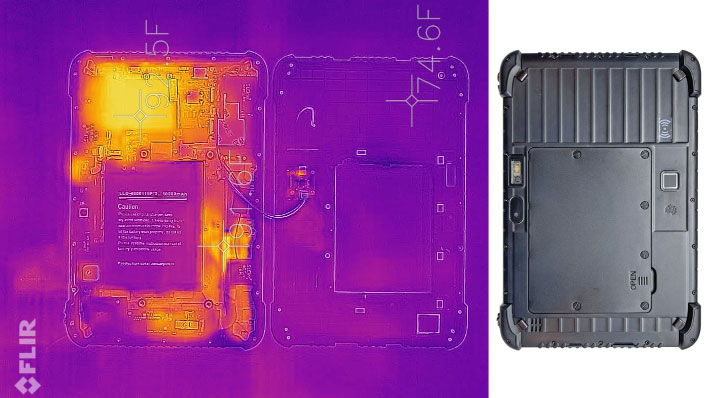
Le IN-I16H peut être équipé de l'un des deux lecteurs de codes à barres disponibles en option. Notre unité d'eval a eu le scanner linéaire du zèbre SE655 E100R. Un imageur 1D/2D Honeywell N3560 est l'autre option.
Ci-dessous quelques détails de conception de cette tablette Emdoor OEM. En plus du bloc qui abrite l'antenne WiFi en option, la caméra, le lecteur de code-barres en option et le module haut débit mobile 4G en option. Le bas à gauche montre comment Emdoor sécurise les vis qui fixent le cadre en magnésium à la moitié avant du boîtier avec une cuillerée de colle pour s'assurer qu'elles ne se détacheront pas. En bas à droite, le joint de boîtier à rainure et languette complexe de précision.
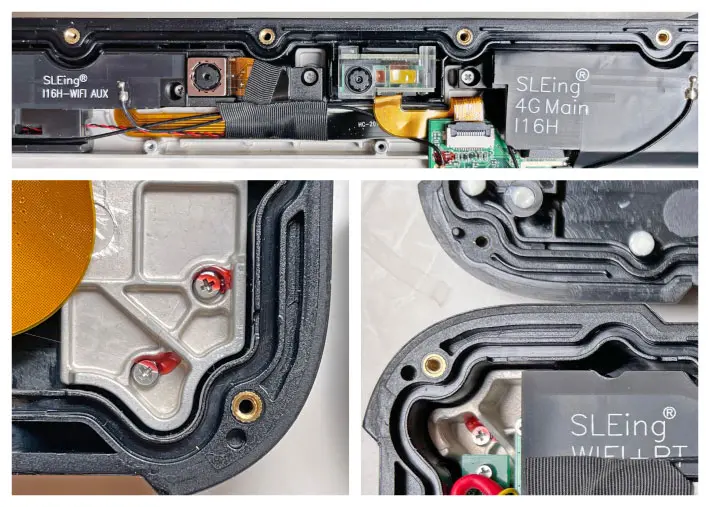
Dans l'ensemble, l'intérieur de la IN-I16H Emdoor laisse une très bonne impression. Composants de qualité et de l'ingénierie clairement mis la tablette en dehors des produits génériques de whitebox, et le châssis de magnésium forte ajoute à la fois la force et l'efficacité thermique.
Affichage contemporain-10,1 pouces et procap multi-touch
Alors que les écrans de smartphones modernes sont dans la gamme de 5 à 6,5 pouces (en diagonale) et les ordinateurs portables modernes généralement dans la gamme de 12 à 16 pouces, les écrans de 10 pouces restent les plus populaires dans les tablettes. Plus petit signifie pas beaucoup plus d'espace que les grands smartphones d'aujourd'hui, plus grand signifie taille et poids supplémentaires. 10 pouces est aussi à peu près l'extrémité inférieure de ce que ceux a besoin pour Windows 10. Vous pouvez utiliser Windows sur des tablettes plus petites, mais nous trouvons qu'il faut un écran de 10 pouces minimum pour faire un vrai travail avec Windows.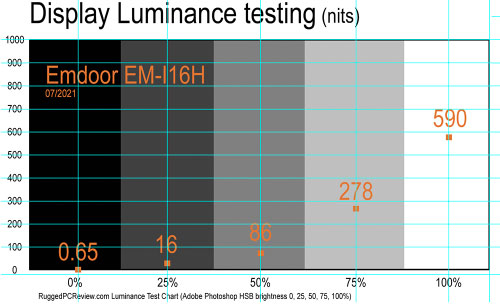 L'Emdoor dispose IN-I16H d'un écran IPS multi-touch capacitif de 10,1 pouces avec une résolution de 1280x800 pixels. Cela fait 149 pixels par pouce-pas très net, mais suffisant pour la plupart des applications. Comme il s'agit d'un écran IPS, il existe des angles de vision parfaits et aucun changement de couleur ou de contraste sous n'importe quel angle. L'affichage est répertorié dans la fiche technique comme ayant une luminance de 400 nits.
L'Emdoor dispose IN-I16H d'un écran IPS multi-touch capacitif de 10,1 pouces avec une résolution de 1280x800 pixels. Cela fait 149 pixels par pouce-pas très net, mais suffisant pour la plupart des applications. Comme il s'agit d'un écran IPS, il existe des angles de vision parfaits et aucun changement de couleur ou de contraste sous n'importe quel angle. L'affichage est répertorié dans la fiche technique comme ayant une luminance de 400 nits.
"Nits" est la mesure couramment utilisée pour la luminosité de l'affichage. Nits est vraiment candela par mètre carré, ou cd/m2, et cela, selon le dictionnaire Google, est "l'intensité lumineuse, dans une direction donnée, d'une source qui émet un rayonnement monochromatique de fréquence 540 × 1012Hz et a une intensité rayonnante dans cette direction de 1/683 watt par stéradian."
Les ordinateurs portables standard génèrent environ 200 nits. Les tablettes et les smartphones grand public peuvent aller jusqu'à 500 et 600 nits. Et les ordinateurs portables robustes à usage spécial peuvent générer jusqu'à 1 500 nits. Lors de nos tests, nous avons constaté que l'écran IN-I16H était en fait un peu plus lumineux que ses 400 nits répertoriés-notre équipement de test mesurait 590 nits, soit à peu près autant qu'un Apple iPad Pro.
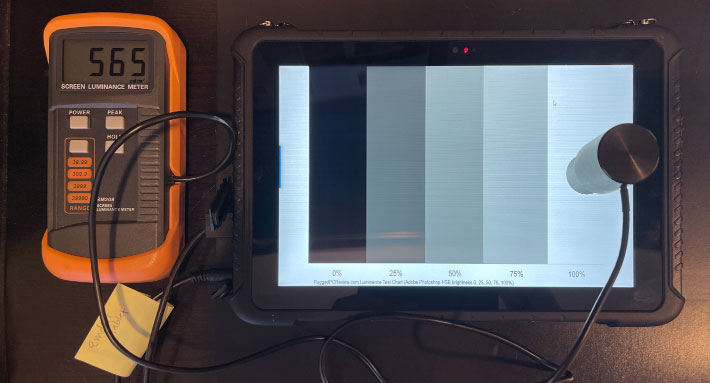
Comme pratiquement tous les écrans de smartphones et de tablettes aujourd'hui, le IN-I16H dispose d'un écran transmissif "brillant" avec des traitements optiques pour offrir autant de visibilité extérieure que possible. Les écrans brillants "pop" et font des affichages dynamiques, mais à l'extérieur tout dépend de l'angle et des réflexions. Les images ci-dessous montrent la tablette à l'extérieur par une fin de matinée brillante dans diverses conditions d'observation.
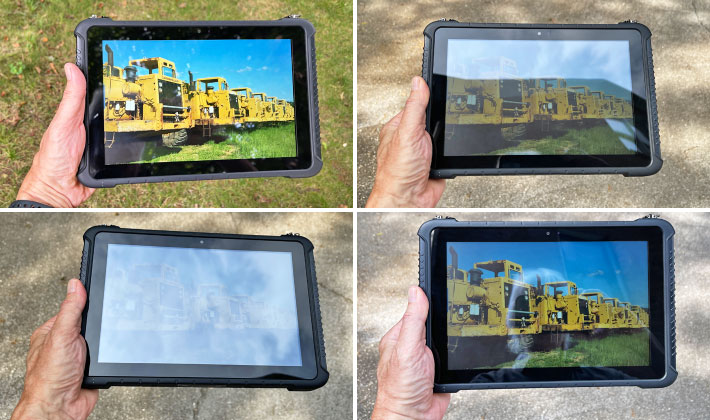
Dans l'ensemble, l'affichage IN-I16H fonctionne très bien. Il est lumineux et vibrant à l'intérieur, et assez lumineux pour une utilisation en extérieur. Il offre des angles de vision presque parfaits dans toutes les directions, sans modifier la luminosité, la couleur ou le contraste.
Caméras
Comme presque toutes les tablettes de nos jours, la IN-I16H Emdoor dispose à la fois d'une caméra avant et arrière. Le front est principalement destiné aux appels vidéo WiFi et aux conférences, et offre une résolution de 2 mégapixels. Le plus puissant à l'arrière est pour la documentation et la photographie générale et est livré en standard avec un imageur de 5 mégapixels modeste pour aujourd'hui avec autofocus.L'application Windows Caméra intégrée dans notre unité d'examen pourrait aller aussi haut que 5mp alambics (2560x1440 pixels) et 1920x1080 pixel vidéo FHD. Pour la vidéo, la caméra dépasse à 1080p/30fps. L'application Microsoft Windows Caméra est généralement très limitée dans ses paramètres et options, mais dispose au moins d'un "mode Pro" dans cette tablette OEM Emdoor. Avec le mode Pro activé, l'application offre un délai; à la fois automatique ou manuel balance des blancs et mise au point; manuel ISO, et compensation d'exposition. Il existe différents modes de prise de vue (panorama, vidéo, photo, document et tableau blanc). C'est plus que l'application Windows Caméra dans la plupart des systèmes. Mais ne pas pouvoir profiter du 5mp déjà modeste de la caméra est un inconvénient.
Les photos ci-dessous ont été prises avec la caméra arrière IN-I16H en mode 2560x1440. Cliquez sur l'image pour afficher une version en taille réelle.
Compte tenu de l'incroyable qualité d'image des smartphones d'aujourd'hui, les utilisateurs attendent beaucoup de leurs appareils photo mobiles. La caméra IN-I16H est en fait meilleure que ce que nous attendons de tablettes robustes. L'appareil photo est assez rapide, vous pouvez sélectionner le point de mise au point, il y a un contrôle manuel adéquat, les images sont nettes et de bonne qualité.
Dur et durable
Alors que les tablettes grand public sont vendues sur un design élégant et la dernière technologie, les tablettes OEM/ODM comme la tablette IN-I16H Emdoor sont des outils pour le travail. Ils sont conçus pour travailler sans avoir besoin d'un étui de protection et sans avoir besoin d'être manipulés avec les gants d'enfant proverbiaux. Chaque fois que vous êtes plus soucieux de ne pas gratter et de ne pas casser un outil que de l'utiliser comme il est censé être utilisé, vous avez le mauvais outil. Le IN-I16H n'est pas un de ces outils fragiles.
Au lieu de cela, comme la plupart des tablettes robustes, le IN-I16H n'a pas besoin d'un étui de protection et il peut être utilisé sans soucis. Il n'y a pas besoin d'un protecteur d'écran parce que le verre de l'écran est épais et assez fort. Il n'y a pas de garniture en métal ou en plastique brillante qui se raye ou se casse facilement, seulement ce polyuréthane thermoplastique résistant qui est à peu près invulnérable.
Selon les normes de test de robustesse établies, à quel point cette tablette est-elle difficile? C'est un peu plus difficile à déterminer. Le IN-I16H porte le cachetage IP65 où le «6» signifie qu'il est complètement antipoussière, et le «5» qu'il est également protégé contre les jets d'eau à basse pression de toutes les directions. Donc, pas de soucis au sujet d'un déversement d'un soda sur elle ou un peu de pluie ou plus.
Le dispositif peut également manipuler des baisses de quatre pieds. Cela signifie qu'il peut facilement survivre à la chute d'un bureau ou d'un chariot. Et quatre pieds est également à peu près la distance qu'une tablette tombe si elle glisse hors de ses mains tout en l'utilisant dans une position debout.
La plage de température de fonctionnement indiquée de-4 à 140 degrés Fahrenheit (-20 à 60 degrés Celsius) est suffisamment large pour à peu près n'importe quel déploiement à court d'utilisation prolongée dans les congélateurs commerciaux ou les environnements arctiques.
Les images ci-dessous montrent certaines des procédures de test que tous les produits robustes Emdoor doivent subir. Ceux-ci incluent, sans ordre particulier, étanchéité et étanchéité à l'air, haute et basse température, corrosion au brouillard salin, test de chute de métal nu, test de rouleau, résistance aux chocs, résistance aux vibrations, chute de boule d'écran, test de porte de protection, test de friction, test statique, test de couleur, produits chimiques et tests de frottement, et plus.
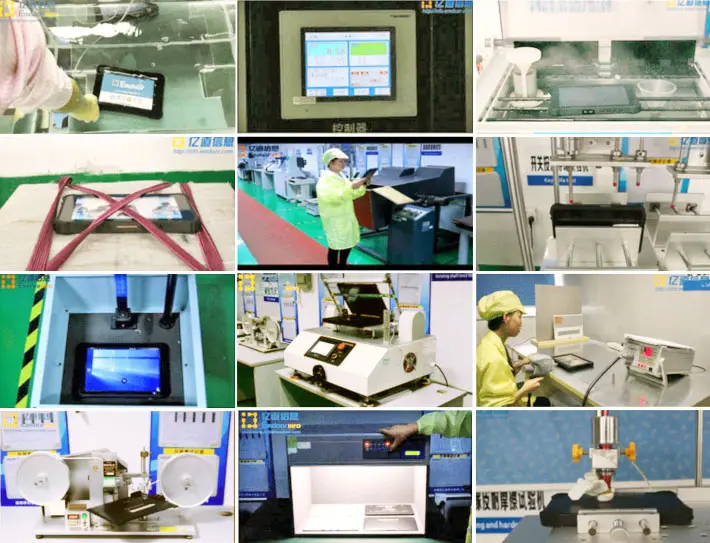
Emdoor fournit également des services de certification de produits à la fois pour les commissions techniques gouvernementales et privées et pour les licences de logiciels/normes.
Résumé: IN-I16H Emdoor
Avec IN-I16H, Infos Emdoorrmation met à disposition une solution de tablette Windows 10 pouces économique adaptée à une grande variété d'environnements et d'applications. Emdoor propose la plate-forme dans différentes configurations et schémas de couleurs, adaptés à toutes sortes de rebranding, exigences de revente, ainsi que pour des projets et solutions clés en ligne.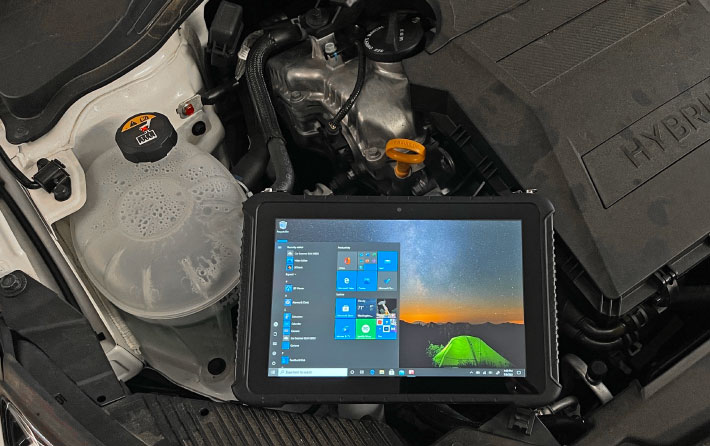
Le IN-I16H, qui pèse un peu plus de deux livres, présente un look élégant et professionnel qui communique clairement sa robustesse inhérente. Son boîtier en polyuréthane thermoplastique résistant ne rayera pas ou ne se cassera pas facilement, et son écran capacitif multi-touch de 10,1 pouces avec d'excellents angles de vision est net et net. L'affichage sur notre unité d'examen a permis une visualisation facile à l'extérieur. Les deux caméras de la tablette sont remarquablement bonnes. La batterie principale de 37 watts-heure accessible et remplaçable de l'extérieur peut durer un quart de travail complet.
Les performances fournies par son processeur Atome d'Intel frugal sont adéquates pour de nombreux travaux, mais ce n'est pas dans la classe de processeur Intel Core. Un scanner intégré facultatif d'industriel-catégorie fait la lecture du code barres 1D/2D. NFC, GPS et haut débit mobile sont tous disponibles en option. L'appareil dispose d'une fente pour carte micro SD dans son compartiment à piles et offre une bonne connectivité filaire.
La conception interne de la tablette est robuste, logique, rationnelle et devrait être facile à réparer/entretenir. La mise en page et l'organisation permettent une personnalisation facile. Dans l'ensemble, le IN-I16H Emdoor est une plate-forme de tablette Windows 10 pouces polyvalente pratique et économique qui est beaucoup plus durable que n'importe quelle tablette grand public. -- Conrad H. Blickenstorfer, juillet 2021
Spécifications IN-I16H Emdoor |
| Options disponibles | ||
| Ajouté/changé | Revue complète 07/2021 | |
| Type | PC rocailleux de comprimé d'OEM | |
| Processeur | Quad-core Atome d'Intel "Cherry Trail" Atom X5-Z8350 (1.44GHz/1.92GHz) | NA |
| Graphiques | Intel Gen8 HD Graphiques | NA |
| OS | Microsoft Windows 10 S Mode 32bit | Windows 10 Pro 32/64bit, Windows 10 IoT 32/64bit |
| RAM standard/max | 4GB | NA |
| Disque/lecteur | Disque à l'état solide de 32 Go eMMC | 64GB eMMC |
| Type d'affichage | IPS TFT LCD, 400 nits (590 nits mesurés), verre de couverture chimiquement durci | AG, AR, revêtements d'AF |
| Taille/résolution d'affichage | 10.1 "1.280x800 pixels (149 pixels par pouce) | 1 920x1 200 pixels (224 ppi) |
| Numériseur | Capacitif 10 points multi-touch, 7H anti-rayures | NA |
| Clavier/touches | Puissance, volume haut/bas, P, F | NA |
| Navigation | Toucher | NA |
| Fentes d'expansion | 1 x micro SDXC (jusqu'à 128 Go), 1 x SIM | NA |
| Logement | Avant en caoutchouc polyuréthane thermoplastique avec plaque arrière en magnésium, option anti-microbienne | NA |
| Couleur du boîtier | Noir avant et arrière | Avant noir et argent, arrière noir |
| Taille | 11,0x7,4x0,87 pouces (280x187x22mm) | NA |
| Poids | 2,2 livres (1,0 kg) | NA |
| Température de fonctionnement | -4 ° à 140 °F (-20 ° à 60 °C) | NA |
| Protection d'entrée | IP65 (totalement étanche à la poussière, protégé contre les jets d'eau à basse pression de toutes les directions) | NA |
| Humidité | 95% sans condensation | NA |
| Goutte | Gouttes de 4 pieds pour MIL-STD-810G | NA |
| Vibration | Est: MIL-STD-810G, méthode 514,6, procédure I, catégories 4 et 20 | NA |
| ESD | Est: Reliez ± 8KV pour tout le métal dehors. Air ± 15KV pour tout le métal extérieur et panneau tactile. | NA |
| Puissance | 3.7V, 10,000mAH, 37 watt-heure amovible, batterie Li-Ion polymère rechargeable | Protection contre les surtensions |
| Caméra | Avant: 2 mégapixels; arrière: 5 mégapixels AF | NA |
| GPS | NEO-7 uBlox | NA |
| Lecteur code-barres | Aucun | Imageur intégré de CCD du zèbre SE655 E100R de 1D OU 1D/2D Honeywell N3680 |
| NFC | Aucun | NXP NFC 13.56MHz (14443A/14443B/15693/18092/ mifare) |
| Capteurs | Lumière ambiante, G-capteur | NA |
| Sécurité | Lecteur d'empreintes digitales | |
| WiFi | Double bande Intel 3165D2WG 802.11a/b/g/n/ac | NA |
| Bluetooth | BT4.2 (BLE) Classe 1 (distance de 10 mètres) | NA |
| WWAN 3G | Aucun | FIBOCOM H350 GSM/GPRS/EDGE, WCDMA, |
| WWAN 4G | Aucun | LTE FDD: B1/B3/B5/B7/B8/B20/B28A LTE TDD: B38/B40/B41 WCDMA: B1/B2/B5/B8 |
| Audio | 1x3.5mm audio | NA |
| Quai | 1 x broche pogo 12 broches | NA |
| USB | 1 x USB 2.0 Type A, 1 x Micro USB | NA |
| HDMI | 1 x HDMI 1.4a Type C | NA |
| Série | 1 x DB9 RS232 TTL | NA |
| LAN | 1x10/100 RJ45 | NA |
| Prix | Renseignez-vous | |
| Réglementaire | FCC, IATA, ROHS | |
| Fiche de Spec |  IN-I16H fiche technique emdoor (PDF) IN-I16H fiche technique emdoor (PDF) | |
| Page Web | Emdoor IN-I16H web | |
| Contact | Siège social d'Emdoor Shenzen 3/F, 5ème boulevard, route merveilleuse de Daobao du parc technologique no. 83 de vallée de la sagesse de la vie, secteur de Bao'an Ville de Shenzhen, Chine Tél: 86-(0)755-2372 2880 Cellulaire: 86-18128844520 Www.emdoorrugged.com Marketing.info @ emdoor.com |










